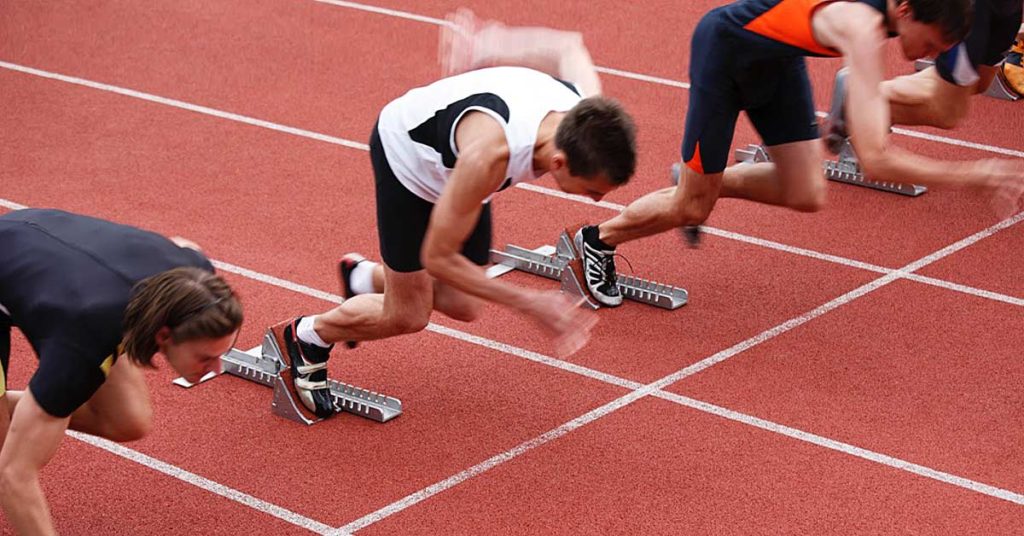
Looking back at some of the pieces I’ve written for this website, I noticed that I have a particular penchant for lengthy preambles. I’m not going to do that this time. And yes, I recognize that by mentioning my previous preambular pattern, I’ve created another preamble of sorts — BUT! — I contest it is not all that lengthy, and it is, therefore, okay. Let me begin.
Today, I will share a workout with you that I like quite a bit. Athletes I have coached also like this workout, and I think your athletes will like it, too. In fact, in the category of max-speed workouts, this might even become your favorite.
In the category of max-speed workouts, this one might become your favorite, says @TrackCoachTG. Share on XLet me first clarify what I mean when I say “max-speed workout.” For the average high school athlete, max speed is often attained somewhere between 30 and 40 meters into an all-out sprint. Even the most elite sprinters in the world can only maintain maximum speed for a couple of seconds before deceleration begins. Therefore, an all-out sprint of up to around 60 meters is what I consider “max speed.” This allows athletes to get up to their top speed and remain in that speed window for about 20 or so meters without sprinting over the metaphorical hump and into deceleration territory. That means anything over 60 meters is no longer a max-speed workout for the majority of high school athletes.
In addition, running fast requires adequate rest. Track and field coaches have long subscribed to the rule of thumb that every 10 meters of maximal effort requires one minute of rest in order for similarly high outputs to be achieved on the next rep. In other words, if you’re not giving your athletes maximal rest, then you aren’t training their max speed.
Given those constraints, a max-speed workout is a workout that includes full-intensity sprints of between 40 and 60 meters completed with adequate rest in between to perform at full intensity again. You’ll probably do four to six reps in total. I think I see a pattern emerging. Forty to 60 meters. Four to six minutes of rest. Four to six total reps. In the famous words of Owen Wilson, “Wow.”
So? Here’s the Workout
I’m not sure what to call it, but it’s 4 x 60 meters. In spikes. On the track. Preferably on a warm and sunny day.
If you’re scratching your head right now, wondering, “what’s so great about that?” just hang in there with me for a minute. If you’re scratching your head for some other reason, consider switching to Head and Shoulders (note: I have no affiliation with Head and Shoulders or with Procter and Gamble).
Like many workouts, there is so much more than the sets, reps, or distances that make this one fun and effective. So, here’s where the real flavor starts to come in.
To run this workout, here’s what you will need:
- Groups of five athletes with similar speed capabilities
- A meter stick or tape measure
- Chalk
- At least two coaches—one at the start and one at the finish
- Starting blocks
- A clipboard, pen, and paper for scorekeeping
- A prize
I like to start by hyping up the prize. Since I prefer to do this workout on a hot day, I like a big cooler full of ice, with one ice-cold Gatorade per group. Open the cooler and reveal the prizes. Let them emanate their icy aura. Hear the angels sing. Tell the athletes that whoever wins today’s workout in their group will get to sip the cool, sweet nectar. Be extra. Do the most. For even more drama, save this workout for the very end of the season when you may only have five sprinters left. A solitary Gatorade in a big cooler of ice creates a singular effect, indeed.
Take your five athletes and line them up at the starting line. We happen to have a mark for the 70-meter dash on our track. I also know that the final hurdle mark for the 300-meter hurdles is 10 meters from the finish line. My calculator tells me that 70 – 10 = 60, so we sprint from the 70-meter line to the final hurdle marks. If you don’t have a 70-meter mark, that’s okay. The distance from the 100-meter starting line to the third hurdle mark in the women’s 100-meter hurdles is 30 meters, which means… well, you get it. You don’t need to measure 60 meters. It’s already on your track.
So anyway, line ’em up. This is gonna be a race!
The first rep in the sequence is very basic. Treat this as much like a meet-day situation as possible. Call out the starting commands and have runners take their marks, set, and go. The athletes race for 60 meters, and a coach stands at the finish line to determine their finishing order, one through five. This coach holds a clipboard, which holds a sheet of paper on which the coach writes down the order in which the athletes finished. This matters a bunch because it impacts the next rep and the scoring system used to determine workout winners.
After at least six minutes have passed, we repeat this process. But runners are placed at an advantage or disadvantage, depending on where they finished on the previous rep. The runner who finished first will have the biggest disadvantage, and the one who finished last will have the biggest head start.
In other words, if you’re not giving your athletes maximal rest, then you aren’t training their max speed, says @TrackCoachTG. Share on XBecause you’re a plan-ahead’er, before having the athletes come out to the track, you will have used your meter stick and chalk to mark the aforementioned advantages and disadvantages. Lane three will belong to your winning runner, but they will line up 2 meters back from the start. Lane two will be your second-place runner, 1 meter back from the start. Lane four will belong to the third-place runner, lined up at the original starting line. Lane one will belong to the fourth-place runner, lined up 1 meter ahead of the original line. And lane five will belong to your fifth-place runner, lined up 2 meters ahead of the original line.
That means that this rep (and every rep that follows) is actually somewhere between 58 and 62 meters, depending on the athlete. Here’s a visual representation of what I mean.

From this staggered position, you’ll have your group race again, tallying their finishing positions at the end of the race and once again re-seeding for the third rep. Rest, stagger, race, seed, and repeat until you’ve completed all four reps.
Determining the overall group winner comes down to who has accumulated the lowest total score over those four races. For example, for an athlete who finished first, third, second, and first, we would award scores of one, three, two, and one for a total score of seven. And as I discussed at the beginning of this rundown, the athlete with the lowest score is awarded the all-coveted Gatorade. Celebrate this and make a big deal about it. Allow playful trash talk, if that’s your thing, as long as it remains playful.
Although I have not had athletes do this, I suppose it’s possible that one of them might try to game the system, coasting to a third-place finish to get a head start in the next race based upon calculations they did in their head about the score they’ll need to be the overall winner. High schoolers, am I right? But here’s the thing: I would bet dollars to doughnuts that any attempt to do so would only end up harming, not helping, the athlete’s score.
The staggered races will finish very closely, in my experience, and while one kid is trying to coast to third, another is trying not to finish fourth. Or, let’s say one athlete really dogs one out for a fifth-place finish, banking on the head start being enough to earn a first on the next rep. That’s still six points over two reps, the equivalent of two third-place finishes. At the end of the day, the fastest kids who are the fiercest competitors on each rep will be the ones who are rewarded with sweet, sweet victory.
If there happens to be a tie score, you can pit those competitors against each other for any number of tie-breakers. You could have them line up and run one more rep with no stagger. You could put them into an isometric position and award the Gatorade to the last athlete standing. You could have them throw a medicine ball for distance. You could hold a rap battle. You could withhold the Gatorade entirely to teach them that there are winners and losers in life and that a tie is the same as a loss and then chug the Gatorade in their faces, laughing maniacally. (I’m kidding).
This workout is quick and fun, and I’d bet my brother’s pinky toe that it fosters incredibly high intent and a positively competitive spirit, says @TrackCoachTG. Share on XAll in all, this workout takes between 25 and 30 minutes to run, depending on how many groups you have and how much transition time you need between groups for athletes to set their blocks. It’s quick and fun, and I’d bet my brother’s pinky toe that this workout fosters incredibly high intent, a positively competitive spirit, and an interesting twist on the typical max-speed days that you’re probably already doing. Give it a try the next time you want to spice things up at practice. And if you think of a clever name for this thing, let me know.
Since you’re here…
…we have a small favor to ask. More people are reading SimpliFaster than ever, and each week we bring you compelling content from coaches, sport scientists, and physiotherapists who are devoted to building better athletes. Please take a moment to share the articles on social media, engage the authors with questions and comments below, and link to articles when appropriate if you have a blog or participate on forums of related topics. — SF


Simple, efficient, and effective. Well done.
Lookin’ forward to trying this in the Spring!
Could you do this workout but instead of like a normal 60 meters it would be a flying 60, so you build speed until you run at maximum for 60 meters?
You could, but there’s not really any way to standardize the fly-in, so kids might be able to cheat a little.